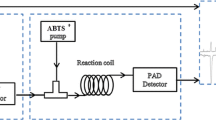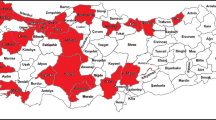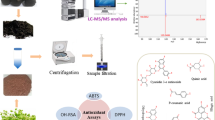Abstract
The current investigation emphasizes the characterization of polyphenolic compounds, antioxidant potential, and mapping of biomarkers in propolis samples acquired from India. LC-ESI-QTOF-MS discovered 67 phytocompounds, including 39 flavonoids, 20 phenolic acids and their derivatives, along with carotenoids and phytosterols in northern Indian propolis. Compounds like: proanthocyanidins, iso-flavonoids, carotenoids, and phytosterols were only detected in particular region samples, recognized as biomarker compounds of specific locations. The spectrophotometric analysis quantified a higher concentration of total flavonoids (TFC) than total phenolic content (TPC) in propolis samples ranging from 228.76 and 214.62 mg QU/g and 137.02–122.13 mg GAE/g, respectively. In addition, antioxidant potential was confirmed highest in Himachal Pradesh propolis (HPP). Total antioxidant capacity (64.91 \(\pm 0.27\) mg Vit C/g), DPPH radical scavenging activity (94.76\(\hspace{0.17em}\pm \hspace{0.17em}0.88\)%), and FRAP (2.25 \(\pm 0.05\) mmol Fe2+/g) but lowest in Rajasthan propolis (RP). Further, HPLC estimated the highest concentration of beta-carotene (217.44 ± 0.58 mg/g) and galangin (184.63 ± 0.75 mg/g) in RP, whereas caffeic acid phenethyl ester (CAPE, 174.65 ± 0.84 mg/g) was highest in HPP samples. Moreover, the antioxidant potency of extracts was efficiently forecasted with TPC, TFC, CAPE, galangin, and beta-carotene concentration using the artificial neural network. Furthermore, principal component analysis recognized three principal components, revealed 98.1% of the variation and well established the dissimilarities in Indian propolis.



Similar content being viewed by others
Date availability
The datasets generated and/or analyzed during the current study are available from the corresponding author upon reasonable request.
References
Fardet A (2016) Minimally processed foods are more satiating and less hyperglycemic than ultra-processed foods: a preliminary study with 98 ready-to-eat foods. Food Funct 7:2338–2346. https://doi.org/10.1039/C6FO00107F
Pant K, Thakur M, Chopra HK et al (2022) Assessment of fatty acids, amino acids, minerals, and thermal properties of bee propolis from Northern India using a multivariate approach. J Food Compos Anal 111:104624. https://doi.org/10.1016/j.jfca.2022.104624
Anjum SI, Ullah A, Khan KA et al (2019) Composition and functional properties of propolis (bee glue): a review. Saudi J Biol Sci 26:1695–1703. https://doi.org/10.1016/j.sjbs.2018.08.013
Vasilaki A, Hatzikamari M, Stagkos-Georgiadis A et al (2019) A natural approach in food preservation: propolis extract as sorbate alternative in non-carbonated beverage. Food Chem 298:125080. https://doi.org/10.1016/j.foodchem.2019.125080
Pobiega K, Kraśniewska K, Gniewosz M (2019) Application of propolis in antimicrobial and antioxidative protection of food quality—a review. Trends Food Sci Technol 83:53–62. https://doi.org/10.1016/j.tifs.2018.11.007
Maruta H, He H (2020) PAK1-blockers: potential therapeutics against COVID-19. Med Drug Discov 6:100039. https://doi.org/10.1016/j.medidd.2020.100039
De Carvalho FMDA, Schneider JK, De Jesus CVF et al (2020) Brazilian red propolis: extracts production, physicochemical characterization, and cytotoxicity profile for antitumor activity. Biomolecules 10:726. https://doi.org/10.3390/biom10050726
Galeotti F, Maccari F, Fachini A, Volpi N (2018) Chemical composition and antioxidant activity of propolis prepared in different forms and in different solvents useful for finished products. Foods 7:41. https://doi.org/10.3390/foods7030041
Das Neves MVM, Da Silva TMS, Lima EDO et al (2016) Isoflavone formononetin from red propolis acts as a fungicide against Candida sp. Braz J Microbiol 47:159–166. https://doi.org/10.1016/j.bjm.2015.11.009
Maldonado L, Marcinkevicius K, Borelli R et al (2020) Differentiation of argentine propolis from different species of bees and geographical origins by UV spectroscopy and chemometric analysis. J Saudi Soc Agric Sci 19:185–191. https://doi.org/10.1016/j.jssas.2018.09.003
El-Guendouz S, Lyoussi B, Miguel MG (2019) Insight on propolis from mediterranean countries: chemical composition biological activities and application fields. C&B. https://doi.org/10.1002/cbdv.201900094
McDonald S, Prenzler PD, Antolovich M, Robards K (2001) Phenolic content and antioxidant activity of olive extracts. Food Chem 73:73–84. https://doi.org/10.1016/S0308-8146(00)00288-0
Kumazawa S, Hamasaka T, Nakayama T (2004) Antioxidant activity of propolis of various geographic origins. Food Chem 84:329–339. https://doi.org/10.1016/S0308-8146(03)00216-4
Brand-Williams W, Cuvelier ME, Berset C (1995) Use of a free radical method to evaluate antioxidant activity. LWT Food Sci Technol 28:25–30. https://doi.org/10.1016/S0023-6438(95)80008-5
Kuś PM, Okińczyc P, Jakovljević M et al (2018) Development of supercritical CO2 extraction of bioactive phytochemicals from black poplar (Populus nigra L.) buds followed by GC–MS and UHPLC-DAD-QqTOF-MS. J Pharm Biomed Anal 158:15–27. https://doi.org/10.1016/j.jpba.2018.05.041
Prieto P, Pineda M, Aguilar M (1999) Spectrophotometric quantitation of antioxidant capacity through the formation of a phosphomolybdenum complex: specific application to the determination of vitamin E. Anal Biochem 269:337–341. https://doi.org/10.1006/abio.1999.4019
Martini S, Conte A, Tagliazucchi D (2017) Phenolic compounds profile and antioxidant properties of six sweet cherry ( Prunus avium) cultivars. Food Res Int 97:15–26. https://doi.org/10.1016/j.foodres.2017.03.030
Thakur M, Nanda V (2021) Screening of Indian bee pollen based on antioxidant properties and polyphenolic composition using UHPLC-DAD-MS/MS: A multivariate analysis and ANN based approach. Food Res Int 140:110041. https://doi.org/10.1016/j.foodres.2020.110041
Choi YM, Noh DO, Cho SY et al (2006) Antioxidant and antimicrobial activities of propolis from several regions of Korea. LWT Food Sci Technol 39:756–761. https://doi.org/10.1016/j.lwt.2005.05.015
Ozdal T, Ceylan FD, Eroglu N et al (2019) Investigation of antioxidant capacity, bioaccessibility and LC-MS/MS phenolic profile of Turkish propolis. Food Res Int 122:528–536. https://doi.org/10.1016/j.foodres.2019.05.028
Ahn M-R, Kumazawa S, Usui Y et al (2007) Antioxidant activity and constituents of propolis collected in various areas of China. Food Chem 101:1383–1392. https://doi.org/10.1016/j.foodchem.2006.03.045
Moreira L, Dias LG, Pereira JA, Estevinho L (2008) Antioxidant properties, total phenols and pollen analysis of propolis samples from Portugal. Food Chem Toxicol 46:3482–3485. https://doi.org/10.1016/j.fct.2008.08.025
Kolaylı S, Birinci C, Kara Y et al (2023) A melissopalynological and chemical characterization of Anatolian propolis and an assessment of its antioxidant potential. Eur Food Res Technol 249:1213–1233. https://doi.org/10.1007/s00217-023-04208-x
Hernández Zarate MS, Abraham Juárez MDR, Cerón García A et al (2018) Flavonoids, phenolic content, and antioxidant activity of propolis from various areas of Guanajuato, Mexico. Food Sci Technol 38:210–215. https://doi.org/10.1590/fst.29916
Odunola O, Jo O, Gbadegesin M (2015) In vitro free radical scavenging and antioxidant properties of ethanol extract of Terminalia glaucescens. Phcog Res 7:49. https://doi.org/10.4103/0974-8490.147200
Tlak Gajger I, Pavlović I, Bojić M et al (2017) Components responsible for antimicrobial activity of propolis from continental and Mediterranean regions in Croatian. Czech J Food Sci 35:376–385. https://doi.org/10.17221/103/2017-CJFS
Mašek T, Perin N, Racané L et al (2018) Chemical composition antioxidant and antibacterial activity of different extracts of poplar type propolis. Croat Chem Acta. https://doi.org/10.5562/cca3298
Ncube EN, Mhlongo MI, Piater LA et al (2014) Analyses of chlorogenic acids and related cinnamic acid derivatives from Nicotiana tabacumtissues with the aid of UPLC-QTOF-MS/MS based on the in-source collision-induced dissociation method. Chem Cent J 8:66. https://doi.org/10.1186/s13065-014-0066-z
Ristivojević P, Trifković J, Andrić F, Milojković-Opsenica D (2015) Poplar-type propolis: chemical composition, botanical origin and biological activity. Nat Prod Commun 10:1934578X1501001. https://doi.org/10.1177/1934578X1501001117
Machado De-Melo AA, Almeida-Muradian LBD, Sancho MT, Pascual-Maté A (2018) Composition and properties of Apis mellifera honey: a review. J Apic Res 57:5–37. https://doi.org/10.1080/00218839.2017.1338444
Boerjan W, Ralph J, Baucher M (2003) Lignin biosynthesis. Annu Rev Plant Biol 54:519–546. https://doi.org/10.1146/annurev.arplant.54.031902.134938
Falcão SI, Tomás A, Vale N et al (2013) Phenolic quantification and botanical origin of Portuguese propolis. Ind Crops Prod 49:805–812. https://doi.org/10.1016/j.indcrop.2013.07.021
Boulekbache-Makhlouf L, Slimani S, Madani K (2013) Total phenolic content, antioxidant and antibacterial activities of fruits of Eucalyptus globulus cultivated in Algeria. Ind Crops Prod 41:85–89. https://doi.org/10.1016/j.indcrop.2012.04.019
Hirano Y, Kondo R, Sakai K (2003) 5Α-Reductase inhibitory tannin-related compounds isolated from Shorea laeviforia. J Wood Sci 49:339–343. https://doi.org/10.1007/s10086-002-0481-y
Kang J, Price WE, Ashton J et al (2016) Identification and characterization of phenolic compounds in hydromethanolic extracts of sorghum wholegrains by LC-ESI-MSn. Food Chem 211:215–226. https://doi.org/10.1016/j.foodchem.2016.05.052
Bankova V, Popova M, Bogdanov S, Sabatini A-G (2002) Chemical composition of european propolis: expected and unexpected results. Zeitschrift für Naturforschung C 57:530–533. https://doi.org/10.1515/znc-2002-5-622
Truchado P, Ferreres F, Tomas-Barberan FA (2009) Liquid chromatography–tandem mass spectrometry reveals the widespread occurrence of flavonoid glycosides in honey, and their potential as floral origin markers. J Chromatogr A 1216:7241–7248. https://doi.org/10.1016/j.chroma.2009.07.057
Haddouchi F, Chaouche TM, Ksouri R, Larbat R (2021) Leafy stems of Phagnalon saxatile subsp. saxatile from algeriaas a source of chlorogenic acids and flavonoids with antioxidant activity: characterization and quantification using UPLC-DAD-ESI-MSn. Metabolites 11:280. https://doi.org/10.3390/metabo11050280
González-Martín M, Escuredo O, Revilla I et al (2015) Determination of the mineral composition and toxic element contents of propolis by near infrared spectroscopy. Sensors 15:27854–27868. https://doi.org/10.3390/s151127854
Xu F, Liu Y, Zhang Z et al (2009) Quasi-MSn identification of flavanone 7-glycoside isomers in Da Chengqi Tang by high performance liquid chromatography-tandem mass spectrometry. Chin Med 4:15. https://doi.org/10.1186/1749-8546-4-15
Alshehri MM, Sharifi-Rad J, Herrera-Bravo J et al (2021) Therapeutic potential of isoflavones with an emphasis on daidzein. Oxid Med Cell Longev 2021:1–15. https://doi.org/10.1155/2021/6331630
Rufatto LC, Luchtenberg P, Garcia C et al (2018) Brazilian red propolis: chemical composition and antibacterial activity determined using bioguided fractionation. Microbiol Res 214:74–82. https://doi.org/10.1016/j.micres.2018.05.003
Wang H-Y, Li T, Ji R et al (2019) Metabolites of medicarpin and their distributions in rats. Molecules 24:1966. https://doi.org/10.3390/molecules24101966
Kečkeš S, Gašić U, Veličković TĆ et al (2013) The determination of phenolic profiles of Serbian unifloral honeys using ultra-high-performance liquid chromatography/high resolution accurate mass spectrometry. Food Chem 138:32–40. https://doi.org/10.1016/j.foodchem.2012.10.025
Arivalagan M, Roy TK, Yasmeen AM et al (2018) Extraction of phenolic compounds with antioxidant potential from coconut (Cocos nucifera L.) testa and identification of phenolic acids and flavonoids using UPLC coupled with TQD-MS/MS. LWT 92:116–126. https://doi.org/10.1016/j.lwt.2018.02.024
Tan Z, Sun Y, Liu M et al (2020) Retracted: naringenin inhibits cell migration, invasion, and tumor growth by regulating circFOXM1/miR-3619-5p/SPAG5 axis in lung cancer. Cancer Biother Radiopharm 35:e826–e838. https://doi.org/10.1089/cbr.2019.3520
Anari E, Akbarzadeh A, Zarghami N (2016) RETRACTED ARTICLE: Chrysin-loaded PLGA-PEG nanoparticles designed for enhanced effect on the breast cancer cell line. Artif Cells, Nanomed, Biotechnol 44:1410–1416. https://doi.org/10.3109/21691401.2015.1029633
Pellati F, Prencipe FP, Bertelli D, Benvenuti S (2013) An efficient chemical analysis of phenolic acids and flavonoids in raw propolis by microwave-assisted extraction combined with high-performance liquid chromatography using the fused-core technology. J Pharm Biomed Anal 81–82:126–132. https://doi.org/10.1016/j.jpba.2013.04.003
Piccinelli AL, Mencherini T, Celano R et al (2013) Chemical composition and antioxidant activity of Algerian propolis. J Agric Food Chem 61:5080–5088. https://doi.org/10.1021/jf400779w
Castro C, Mura F, Valenzuela G et al (2014) Identification of phenolic compounds by HPLC-ESI-MS/MS and antioxidant activity from Chilean propolis. Food Res Int 64:873–879. https://doi.org/10.1016/j.foodres.2014.08.050
Karagecili H, Yılmaz MA, Ertürk A et al (2023) Comprehensive metabolite profiling of berdav propolis using LC-MS/MS: determination of antioxidant, anticholinergic, antiglaucoma, and antidiabetic effects. Molecules 28:1739. https://doi.org/10.3390/molecules28041739
Ninomiya M, Koketsu M (2013) Minor flavonoids (chalcones, flavanones, dihydrochalcones, and aurones). In: Ramawat KG, Mérillon J-M (eds) Natural products. Springer Berlin Heidelberg, Berlin, Heidelberg, pp 1867–1900
Madeo F, Carmona-Gutierrez D, Kepp O, Kroemer G (2018) Spermidine delays aging in humans. Aging 10:2209–2211. https://doi.org/10.18632/aging.101517
Qiao J, Feng Z, Zhang Y et al (2023) Phenolamide and flavonoid glycoside profiles of 20 types of monofloral bee pollen. Food Chem 405:134800. https://doi.org/10.1016/j.foodchem.2022.134800
Van Breemen RB, Dong L, Pajkovic ND (2012) Atmospheric pressure chemical ionization tandem mass spectrometry of carotenoids. Int J Mass Spectrom 312:163–172. https://doi.org/10.1016/j.ijms.2011.07.030
Bonamigo T, Campos JF, Alfredo TM et al (2017) Antioxidant, cytotoxic, and toxic activities of propolis from two native bees in Brazil: Scaptotrigona depilis and Melipona quadrifasciata anthidioides. Oxid Med Cell Longev 2017:1–12. https://doi.org/10.1155/2017/1038153
Rozenberg R, Ruibal-Mendieta NL, Petitjean G et al (2003) Phytosterol analysis and characterization in spelt (Triticum aestivum ssp. spelta L.) and wheat (T. aestivum L.) lipids by LC/APCI-MS. J Cereal Sci 38:189–197. https://doi.org/10.1016/S0733-5210(03)00022-5
Kruger MJ, Davies N, Myburgh KH, Lecour S (2014) Proanthocyanidins, anthocyanins and cardiovascular diseases. Food Res Int 59:41–52. https://doi.org/10.1016/j.foodres.2014.01.046
Tan L, Jin Z, Ge Y et al (2020) Comprehensive ESI-Q TRAP-MS/MS based characterization of metabolome of two mango (Mangifera indica L) cultivars from China. Sci Rep 10:20017. https://doi.org/10.1038/s41598-020-75636-y
Garrido J, Gaspar A, Garrido EM et al (2012) Alkyl esters of hydroxycinnamic acids with improved antioxidant activity and lipophilicity protect PC12 cells against oxidative stress. Biochimie 94:961–967. https://doi.org/10.1016/j.biochi.2011.12.015
Escriche I, Juan-Borrás M (2018) Standardizing the analysis of phenolic profile in propolis. Food Res Int 106:834–841. https://doi.org/10.1016/j.foodres.2018.01.055
Popova M, Trusheva B, Khismatullin R et al (2013) The triple botanical origin of Russian propolis from the perm region, its phenolic content and antimicrobial activity. Nat Prod Commun 8:1934578X1300800. https://doi.org/10.1177/1934578X1300800519
Sun C, Wu Z, Wang Z, Zhang H (2015) Effect of ethanol/water solvents on phenolic profiles and antioxidant properties of Beijing propolis extracts. Evid-Based Complement Altern Med 2015:1–9. https://doi.org/10.1155/2015/595393
Mouhoubi-Tafinine Z, Ouchemoukh S, Tamendjari A (2016) Antioxydant activity of some Algerian honey and propolis. Ind Crops Prod 88:85–90. https://doi.org/10.1016/j.indcrop.2016.02.033
Fanciullino A-L, Dhuique-Mayer C, Luro F et al (2006) Carotenoid diversity in cultivated citrus is highly influenced by genetic factors. J Agric Food Chem 54:4397–4406. https://doi.org/10.1021/jf0526644
Kubiliene L, Laugaliene V, Pavilonis A et al (2015) Alternative preparation of propolis extracts: comparison of their composition and biological activities. BMC Complement Altern Med 15:156. https://doi.org/10.1186/s12906-015-0677-5
Silva JC, Rodrigues S, Feás X, Estevinho LM (2012) Antimicrobial activity, phenolic profile and role in the inflammation of propolis. Food Chem Toxicol 50:1790–1795. https://doi.org/10.1016/j.fct.2012.02.097
El-Zaeddi H, Calín-Sánchez Á, Nowicka P et al (2017) Preharvest treatments with malic, oxalic, and acetylsalicylic acids affect the phenolic composition and antioxidant capacity of coriander, dill and parsley. Food Chem 226:179–186. https://doi.org/10.1016/j.foodchem.2017.01.067
Chandrasekara A, Shahidi F (2011) Determination of antioxidant activity in free and hydrolyzed fractions of millet grains and characterization of their phenolic profiles by HPLC-DAD-ESI-MSn. J Funct Foods 3:144–158. https://doi.org/10.1016/j.jff.2011.03.007
Svečnjak L, Marijanović Z, Okińczyc P et al (2020) Mediterranean propolis from the adriatic sea islands as a source of natural antioxidants: comprehensive chemical biodiversity determined by GC-MS, FTIR-ATR, UHPLC-DAD-QqTOF-MS, DPPH and FRAP Assay. Antioxidants 9:337. https://doi.org/10.3390/antiox9040337
Saini RK, Yu J-W, Song M-H et al (2022) Profiling of Redox-Active Lipophilic Constituents in Leaf Mustard (Brassica juncea (L.) Czern.) Cultivars Using LC-MS and GC-MS. Antioxidants 11:2464. https://doi.org/10.3390/antiox11122464
Nakajima Y, Sato Y, Konishi T (2007) Antioxidant small phenolic ingredients in inonotus obliquus (persoon) Pilat (Chaga). Chem Pharm Bull 55:1222–1226. https://doi.org/10.1248/cpb.55.1222
Urushisaki T, Takemura T, Tazawa S et al (2011) Caffeoylquinic acids are major constituents with potent anti-influenza effects in Brazilian green propolis water extract. Evid-Based Complement Altern Med 2011:1–7. https://doi.org/10.1155/2011/254914
Kazemi M, Karim R, Mirhosseini H, Abdul Hamid A (2016) Optimization of pulsed ultrasound-assisted technique for extraction of phenolics from pomegranate peel of Malas variety: punicalagin and hydroxybenzoic acids. Food Chem 206:156–166. https://doi.org/10.1016/j.foodchem.2016.03.017
Moura SALD, Negri G, Salatino A, et al (2011) Aqueous extract of brazilian green propolis: primary components, evaluation of inflammation and wound healing by using subcutaneous implanted sponges. Evid-Based Complement Altern Med 2011:1–8. https://doi.org/10.1093/ecam/nep112
Bajpai V, Singh A, Singh P et al (2018) Development of ultra performance liquid chromatography tandem mass spectrometry method for simultaneous identification and quantitation of potential osteogenic phytochemicals in Butea monosperma. J Chromatogr Sci 56:738–745. https://doi.org/10.1093/chromsci/bmy050
Jiang D, Rasul A, Batool R et al (2019) Potential anticancer properties and mechanisms of action of formononetin. BioMed Res Int 2019:1–11. https://doi.org/10.1155/2019/5854315
Acknowledgements
Authors are grateful to Mr. Jagtar Singh—the progressive beekeeper for collection and donation of the bee propolis samples for current investigation. As well as a special thanks to Pratik Gorde for helping in ANN data modeling. This research did not receive any specific grant from funding agencies in the public, commercial, or not-for-profit sectors. In addition, no AI or AI-assisted tool has been used in the preparation of this manuscript.
Author information
Authors and Affiliations
Corresponding author
Ethics declarations
Conflict of interest
The authors declare no conflict of interest.
Compliance with ethics requirements
This article does not contain any studies with human or animal subjects.
Additional information
Publisher's Note
Springer Nature remains neutral with regard to jurisdictional claims in published maps and institutional affiliations.
Supplementary Information
Below is the link to the electronic supplementary material.
Rights and permissions
Springer Nature or its licensor (e.g. a society or other partner) holds exclusive rights to this article under a publishing agreement with the author(s) or other rightsholder(s); author self-archiving of the accepted manuscript version of this article is solely governed by the terms of such publishing agreement and applicable law.
About this article
Cite this article
Pant, K., Chopra, H.K. & Nanda, V. Characterization and anti-oxidant potential of polyphenolic biomarker compounds of Indian propolis: a multivariate and ANN-based approach. Eur Food Res Technol 250, 253–271 (2024). https://doi.org/10.1007/s00217-023-04384-w
Received:
Revised:
Accepted:
Published:
Issue Date:
DOI: https://doi.org/10.1007/s00217-023-04384-w




